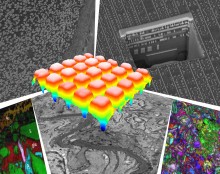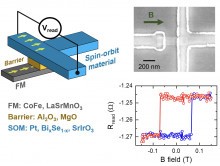Projects at a Glance
SNOMCELL - Near-field microscopy for label-free ultrastructural pathology
This project aims at establishing s-SNOM as a platform technology for label-free ultrastructural pathology. s-SNOM is an emerging technique -- co-developed at nanoGUNE -- that beats the diffraction limit and allows for obtaining infrared images with nanoscale spatial resolution. Applied to ultrathin cell sections, s-SNOM will allow for an unprecedented view on the chemical composition of the interior of a cell that cannot be easily calculated nor measured. Thus, s-SNOM will provide a reference data set that will help to validate already existing medical application of infrared microscopy and may even lead to the discovery of new nano-IR biomarkers.
SPECTER - Spin-charge conversion in highly resistive spin-orbit materials
With the current technology of transistors reaching characteristic sizes of a few nanometers, and heating effects becoming more severe, the regular functionality of processors is at stake. In the next few years, new technologies are required to sustain the increasingly high demands imposed by the consumer electronics industry worldwide. Among the wide range of proposed options, spintronics is considered to be one of the leading candidates to fill this gap, backed by recent proposals for spin-based computation using magnetoelectric spin-orbit devices. In these devices, the magnetic state of a ferromagnetic material is read through the conversion of spin currents in charge currents, where two resistance levels can be unambiguously detected depending on the magnetization direction of the ferromagnet, i.e. a “1” and a ”0” state.
SPIR - Spasers in the infrared range
One of the important directions of modern medicine is noninvasive diagnostics. The urgency of the problem is determined by the search of safe methods of examination and sparing techniques of collection of material for medical analysis when the patient does not feel pain, physical and emotional discomfort.
FunMolSys - On-surface Synthesis of Functional Molecular Systems
This is a collaborative research project funded by the Spanish Research Agency (AEI) for synthetizing functional complex carbon-based molecular nanostructures with atomic precision and testing their potential operability as functional units in various technological applications, such as spintronics, topological engineering, (opto)electronics, thermoelectricity, and chemical and molecular sensing and filtering. FunMolSys combines the work of six Spanish research groups in Galicia (CiQUS at the University of Santiago de Compostela), Euskadi (the CFM, Centro de Física de Materiales - CSIC-UPV, and CIC nanoGUNE), Aragón (the ICMA, Instituto de Ciencia de Materiales de Aragón – CSIC-UZ), and Catalunya (the ICN2, Instituto Catalán de Nanociencia y Nanotecnología). In the last years, FunMolSys has produced novel strategies for synthesis of customized graphene platforms over metallic surfaces and identification of their new electronic and magnetic properties with a combination of multiple experimental methods, theoretical tools, and multidisciplinary expertise. Within FulMolSys, the research groups of Theory and nanoimaging, led by Profs. Artacho and Pascual, respectively, contributed with a sub-project entitled “Magnetism and topological states of on-surface engineered molecular nanosystems”
MicroMech - Nanomechanics of Microbial Infection:Towards Mechanopharmacology
Microbes use surface proteins to infect hosts, with bacterial adhesins, like long filaments, crucial for attachment, resisting mechanical forces from pico to nanoNewtons. This resistance is vital for anchoring in shear-rich environments like urinary tract infections. Understanding the link between adhesin mechanical resistance, attachment ability, and pathogenicity remains incomplete. The proposal aims to study Staphylococcus aureus mechanics in active endocarditis, exploring adhesin proteins Clumping factor A (ClfA) and Fibronectin-binding protein A (FnBPA) connections to infection. Techniques span atomic force spectroscopy, magnetic tweezers, and clinical S aureus strains, seeking to correlate pathogenicity with adhesin mechanics and discover molecules to prevent infections, contributing to Mechanopharmacology.
SYNERFUN - Synergistic Surface Functionalization for Advanced Diagnistic, Catalytic and Packaging Materials
This project aims to leverage our expertise in surface functionalization and hybrid material fabrication to develop new systems for diagnostics, energy conversion, and food packaging. Our capabilities include synthesizing 0D materials (nanoparticles) and 2D materials (atomic scale thin films) and modifying surfaces with hybrid materials to introduce or enhance chemical and physical properties. Our focus will be on developing innovative materials with exciting applications in biomedical diagnostics and therapies, and concepts for enhancing common polymers used for intelligent food packaging in the future.
BRIDGE - Bridging the gap between synthetic polymers and biopolymers physical and chemical properties
The project BRIDGE is aimed at closing the gap between studying polymers and biopolymers. Traditionally, these materials are "at home" in the disciplins of soft matter physics and of biophysics, respectively. Our interdisciplinary approach opens new avenues, of which we explored morphology and dynamics. A special focus was on the role of water, as solvent, and as adsorbed layer.
Molding2D - Molecular engineering of superconducting and ferromagnetic 2D materials: towards on-demand physical properties
Among the ultimate goals of materials science is the fabrication of materials with on-demand capabilities, which could improve current technologies and inspire novel device concepts. Molding2D uses the chemical programmability of molecules to manipulate the intrinsic physical properties of 2D Materials, reaching a controllable tuning of 2D ferromagnetism and superconductivity. By combining a device approach with spectroscopic and structural characterization, Molding2D is the demonstration that molecule/2D Material interfaces constitute an ideal experimental platform to design novel materials with programmable functions.
ENSEMBLES3 Phase II - Centre of ExcelleNce for nanophotonicS, advancEd Materials and novel crystal growth-Based technoLogiEs
The grand objective of the project is to create the Centre of Excellence ENSEMBLE3, which will focus on research excellence and innovation performance in the area of crystal growth-based technologies, novel functional materials with innovative electromagnetic properties, and applications in nanophotonics, optoelectronics and medicine.
By funding program
Contact

Yurdana Castelruiz
Projects Manager
+ 34 943574022
y.castelruiz[at]nanogune.eu




